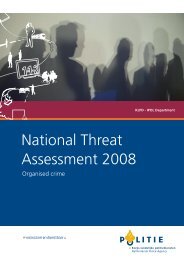Assessing the Effectiveness of Organized Crime Control Strategies ...
Assessing the Effectiveness of Organized Crime Control Strategies ...
Assessing the Effectiveness of Organized Crime Control Strategies ...
You also want an ePaper? Increase the reach of your titles
YUMPU automatically turns print PDFs into web optimized ePapers that Google loves.
charges, arrests, or convictions are indications <strong>of</strong> success. However, such increases may reflect<br />
an increase in criminal activity or simply that <strong>the</strong> relevant agency has benefited from additional<br />
resources.<br />
Conviction and sentence-based measures are also problematic because <strong>the</strong>y discount <strong>the</strong><br />
ancillary benefits <strong>of</strong> prosecution where a conviction or lengthy sentence is not achieved.<br />
Prosecution in itself can have a general deterrent effect, put an end to <strong>the</strong> illicit behaviour under<br />
consideration, bring <strong>the</strong> public’s attention to those who may victimize <strong>the</strong>m, and free sectors <strong>of</strong><br />
<strong>the</strong> economy from infiltration by OC groups (Maltz, 1990: 9).<br />
Measures such as <strong>the</strong> conviction rate may also be counterproductive in terms <strong>of</strong> <strong>the</strong> operations <strong>of</strong><br />
OC strike forces. Maltz (1990:9) argues that <strong>the</strong>se agencies should undertake risky cases and<br />
concern for a high conviction rate would lead <strong>the</strong>m to pursue less risky alternatives. Also,<br />
prosecutors could inflate <strong>the</strong>ir conviction rates by accepting a guilty plea on a lesser charge.<br />
In <strong>the</strong>mselves, <strong>the</strong>refore, such body-counts provide just a starting point, but little in <strong>the</strong> way <strong>of</strong> a<br />
useful indication <strong>of</strong> an initiative’s efficacy or efficiency. It is important to note that <strong>the</strong><br />
Homicide Survey, maintained by <strong>the</strong> Policing Services Programme at <strong>the</strong> Canadian Centre for<br />
Justice Statistics, collects data on “gang-related” homicides.<br />
Size <strong>of</strong> <strong>the</strong> Illicit Market<br />
Attempts have been made in Canada (Porteous, 1998) and elsewhere to ascertain <strong>the</strong> volume <strong>of</strong><br />
OC. Beare and Schneider (1990:2) assert that, “There is no verifiable method for determining<br />
<strong>the</strong> size <strong>of</strong> <strong>the</strong> illicit economy. Estimated figures in this area <strong>of</strong> illicit proceeds, however<br />
carefully calculated, are only guesses. Once stated <strong>the</strong>y take on a reality <strong>the</strong>y do not deserve.”<br />
There are many unknowns in estimating <strong>the</strong> size <strong>of</strong> <strong>the</strong> illicit market in relation to any product or<br />
service. With regard to prohibited drugs, <strong>the</strong> size <strong>of</strong> <strong>the</strong> market is a function <strong>of</strong> <strong>the</strong> quantities<br />
purchased and <strong>the</strong> cost, nei<strong>the</strong>r <strong>of</strong> which has been accurately measured (Kleiman, 1994). Drug<br />
seizures are an inadequate indicator <strong>of</strong> quantity, as only a small percentage is seized. A 10<br />
percent seizure rate is considered highly speculative and variable across drugs and time (van<br />
Duyne, 1996:128). ). Fur<strong>the</strong>rmore, <strong>the</strong> estimates <strong>of</strong> pr<strong>of</strong>it margins that form <strong>the</strong> basis for <strong>the</strong><br />
calculation <strong>of</strong> proceeds from <strong>the</strong> drug trade are also controversial (van Duyne, 1996:129). Drug<br />
prices, sources, and amounts bought are difficult to ascertain as <strong>the</strong>y are usually not probed in<br />
existing drug use surveys (Kleiman, 1994).<br />
Much <strong>of</strong> <strong>the</strong> United States’ data on drug trafficking is collected by <strong>the</strong> National Narcotics<br />
Intelligence Consumer Committee. The Committee concedes that <strong>the</strong>re is a high degree <strong>of</strong><br />
uncertainty in <strong>the</strong> estimates <strong>of</strong> <strong>the</strong> amounts <strong>of</strong> drugs produced and entering <strong>the</strong> US, trafficking<br />
patterns, and prices and purity <strong>of</strong> drugs (President’s Commission on <strong>Organized</strong> <strong>Crime</strong>, 1986:342-<br />
343). The President’s Commission has added that <strong>the</strong>re is no centralized data collected system<br />
on drug seizures, resulting in <strong>the</strong> frequent double and triple reporting <strong>of</strong> <strong>the</strong> same drug bust by<br />
participating agencies.<br />
Research and Statistics Division / Department <strong>of</strong> Justice Canada | 13








